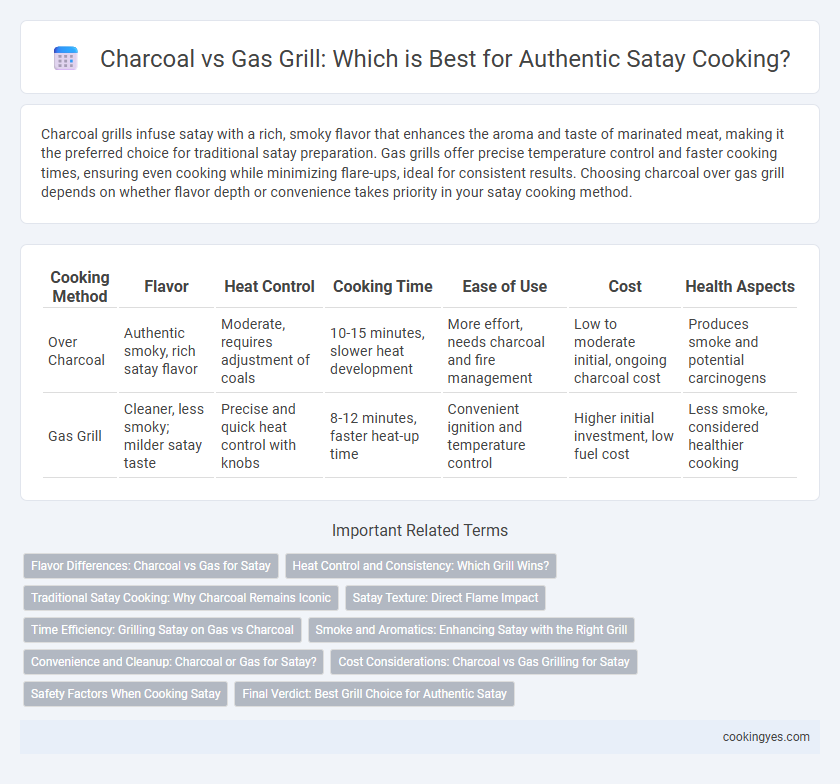Charcoal grills infuse satay with a rich, smoky flavor that enhances the aroma and taste of marinated meat, making it the preferred choice for traditional satay preparation. Gas grills offer precise temperature control and faster cooking times, ensuring even cooking while minimizing flare-ups, ideal for consistent results. Choosing charcoal over gas grill depends on whether flavor depth or convenience takes priority in your satay cooking method.
Table of Comparison
| Cooking Method | Flavor | Heat Control | Cooking Time | Ease of Use | Cost | Health Aspects |
|---|---|---|---|---|---|---|
| Over Charcoal | Authentic smoky, rich satay flavor | Moderate, requires adjustment of coals | 10-15 minutes, slower heat development | More effort, needs charcoal and fire management | Low to moderate initial, ongoing charcoal cost | Produces smoke and potential carcinogens |
| Gas Grill | Cleaner, less smoky; milder satay taste | Precise and quick heat control with knobs | 8-12 minutes, faster heat-up time | Convenient ignition and temperature control | Higher initial investment, low fuel cost | Less smoke, considered healthier cooking |
Flavor Differences: Charcoal vs Gas for Satay
Charcoal grilling imparts a rich, smoky flavor to satay, enhancing the meat's natural taste with subtle charred notes that gas grills often cannot replicate. Gas grills offer more consistent heat and easier temperature control but tend to produce a cleaner flavor profile without the depth provided by charcoal smoke. For authentic satay, charcoal grilling is preferred for its ability to infuse complex smoky aromas, making the dish more flavorful and traditional.
Heat Control and Consistency: Which Grill Wins?
Charcoal grills provide intense, smoky heat that enhances satay's flavor but require skillful heat management to maintain consistent cooking temperatures. Gas grills offer precise heat control through adjustable burners, ensuring uniform cooking and reducing the risk of burning satay skewers. For consistent results and easier temperature regulation, gas grills are often favored, while charcoal grills excel in imparting a traditional smoky aroma.
Traditional Satay Cooking: Why Charcoal Remains Iconic
Charcoal grills impart a distinct smoky flavor and aroma essential to traditional satay, creating a rich, authentic taste that gas grills cannot replicate. The intense, consistent heat from charcoal ensures even cooking and perfect caramelization of the marinade, enhancing the satay's texture and juiciness. Enthusiasts and chefs alike value charcoal for preserving satay's cultural heritage and delivering the signature charred taste integral to this Southeast Asian delicacy.
Satay Texture: Direct Flame Impact
Cooking satay over charcoal creates a distinct smoky aroma and charred exterior that enhances the texture with a slightly crisp and tender bite, thanks to the fluctuating direct flame. Gas grills provide more consistent heat control, resulting in evenly cooked meat but lack the deep smoky flavor and varied caramelization that charcoal imparts. The intense, uneven heat from charcoal promotes Maillard reaction and subtle charring, producing a more complex and authentic satay texture.
Time Efficiency: Grilling Satay on Gas vs Charcoal
Grilling satay on a gas grill significantly reduces cooking time due to rapid heat control and consistent temperature maintenance, enabling faster skewer turnover. Charcoal grills require longer preheating, often 20-30 minutes, but impart a traditional smoky flavor despite slower cooking speeds. Gas grills offer superior time efficiency, ideal for high-volume satay preparation without compromising flavor when managed properly.
Smoke and Aromatics: Enhancing Satay with the Right Grill
Charcoal grills produce intense smoke that infuses satay with a rich, smoky aroma, enhancing its traditional flavor profile more effectively than gas grills. The natural wood smoke from charcoal creates complex aromatic compounds that elevate the satay's taste, while gas grills offer cleaner heat but lack the deep smoky essence. For authentic satay, charcoal grilling remains the preferred method to maximize the interplay of smoke and aromatics.
Convenience and Cleanup: Charcoal or Gas for Satay?
Gas grills offer superior convenience for satay cooking due to instant heat control and quick ignition, reducing prep time significantly. Charcoal grilling requires more effort in lighting and maintaining consistent temperature but imparts a distinctive smoky flavor unique to satay. Cleanup is simpler with gas grills, leaving less ash and residue compared to the extensive cleanup charcoal ash demands.
Cost Considerations: Charcoal vs Gas Grilling for Satay
Charcoal grills for satay typically involve lower initial costs but higher ongoing expenses due to frequent charcoal purchases, averaging $10-$20 per bag with variable quality affecting flavor. Gas grills require a higher upfront investment of $100-$300 but offer more consistent fuel costs, with propane tanks costing around $15-$30 and lasting longer per satay batch. Cost efficiency depends on frequency of use; gas is more economical for regular grilling due to fuel longevity, while charcoal remains favored for small-scale or traditional satay preparation for its authentic smoky aroma.
Safety Factors When Cooking Satay
Cooking satay over charcoal imparts a smoky flavor but requires careful monitoring to prevent flare-ups and carbon monoxide exposure, making ventilation crucial. Gas grills offer more precise temperature control and reduce the risk of uneven cooking or sudden flames, enhancing safety during preparation. Ensuring proper grill maintenance and using heat-resistant gloves are essential safety measures regardless of the grilling method chosen.
Final Verdict: Best Grill Choice for Authentic Satay
Charcoal grills impart a smoky aroma and high, consistent heat essential for authentic satay's signature char and flavor profile. Gas grills offer precise temperature control and convenience but often lack the depth of smoky richness that defines traditional satay. For genuine taste and texture, a charcoal grill remains the preferred choice among satay enthusiasts and culinary experts.
Over charcoal vs Gas grill for satay cooking method Infographic

 cookingyes.com
cookingyes.com